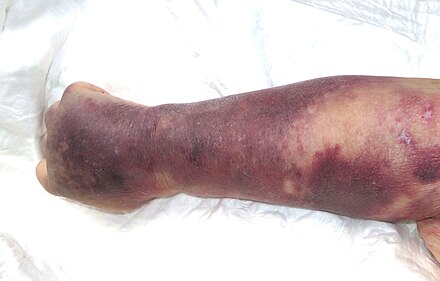Septic Shock
Septic shock is a severe, potentially fatal condition resulting from sepsis, which involves organ injury or damage due to an infection. It is characterised by dangerously low blood pressure and abnormalities in cellular metabolism, leading to a high risk of mortality, particularly in intensive care units (ICUs). The condition is often noted in children, the elderly, and immunocompromised individuals due to their less effective immune responses.

Causes
Septic shock typically follows severe infections caused by bacteria, fungi, viruses, or parasites. Common primary infections include appendicitis, pneumonia, bacteraemia, diverticulitis, pyelonephritis, meningitis, pancreatitis, necrotising fasciitis, MRSA, and mesenteric ischaemia. The infection can occur in various body parts, including the lungs, brain, urinary tract, skin, and abdominal organs.
Pathophysiology
The development of septic shock involves both pro-inflammatory and anti-inflammatory responses to an infection. The inflammatory response leads to a hypermetabolic state, with increased cellular respiration, protein catabolism, and metabolic acidosis. The condition is often precipitated by gramme-positive bacteria, followed by gramme-negative bacteria and fungi.
Gramme-positive Infections
Gramme-positive bacteria produce exotoxins or enterotoxins, divided into three types:
- Type I (cell surface-active toxins) disrupt cells without entering.
- Type II (membrane-damaging toxins) destroy cell membranes.
- Type III (intracellular toxins) interfere with internal cell functions.
Gramme-negative Infections
In gramme-negative sepsis, lipopolysaccharides (LPS) from bacterial membranes bind to LPS-binding proteins, leading to a cascade of immune responses mediated by Toll-like receptor 4 (TLR-4). This results in the production of pro-inflammatory cytokines such as IL-1, IL-6, and TNF-α. The responses can lead to systemic vasodilation, endothelial injury, and disseminated intravascular coagulation (DIC), culminating in multiorgan failure.

Diagnosis
Diagnosis of septic shock involves identifying the presence of infection along with systemic manifestations such as:
- Tachypnea (rapid breathing >20 breaths per minute or PaCO₂ <32 mm Hg).
- Abnormal white blood cell count (either < 4000 or > 12000 cells/mm³).
- Tachycardia (heart rate >90 beats per minute).
- Altered body temperature (fever >38.0°C or hypothermia <36.0°C).
Septic shock is confirmed if low blood pressure persists despite intravenous fluid administration. This is indicated by a systolic blood pressure <90 mm Hg, a mean arterial pressure <70 mm Hg, or a systolic BP decrease of 40 mm Hg or more.
Treatment
Fluids
Fluid resuscitation is very important to counteract the low blood pressure and improve tissue perfusion. Initial resuscitation with at least 30 ml/kg of intravenous crystalloid within the first three hours is recommended. Crystalloids like normal saline and lactated Ringer's solution are preferred over colloids like hydroxyethyl starch.
Antibiotics
Early administration of broad-spectrum antibiotics within the first hour of recognising septic shock is essential. Delays in antibiotic treatment increase the risk of mortality by approximately 10% per hour. Typically, antibiotics are continued for 7–10 days, adjusted based on clinical response.
Vasopressors
Norepinephrine is the preferred vasopressor, with epinephrine and vasopressin as additional options if necessary. Dopamine is reserved for patients with slow heart rates and low risk of arrhythmias. The goal is to maintain a mean arterial pressure (MAP) of 65 mm Hg.
Methylene Blue
Methylene blue has shown utility in septic shock, particularly via the inhibition of the nitric oxide-cyclic guanosine monophosphate pathway. It has been effective in cases resistant to other treatments.
Other Treatments
While the use of β-Blockers, steroids, and Polymyxin B-immobilised fibre column hemoperfusion show some promise, more evidence is required for routine use. Recombinant activated protein C (drotrecogin alpha) is not recommended due to lack of efficacy and increased risk of bleeding.
Epidemiology
Sepsis affects over 20 million people worldwide annually, with septic shock mortality rates reaching up to 50% in industrialised countries. It remains a leading cause of death in ICUs, with a rising incidence attributed to increased use of invasive devices and procedures, a growing population of immunocompromised patients, and an ageing population. Gramme-positive and gramme-negative bacteria are common culprits, with a significant proportion of cases stemming from idiopathic origins.
Self-assessment MCQs (single best answer)
What is a primary cause of septic shock?
Which type of bacteria is most commonly associated with the production of exotoxins?
What is a characteristic sign of septic shock?
Which of the following is the preferred vasopressor in the treatment of septic shock?
What is the recommended initial fluid resuscitation volume for septic shock patients within the first three hours?
Which cytokine is NOT typically involved in the immune response in septic shock?
What is the mortality rate of septic shock in industrialised countries?
Which of the following is NOT a common primary infection leading to septic shock?
Which of the following statements about methylene blue in septic shock is true?
Which of the following is essential to confirm a diagnosis of septic shock?
Dentaljuce
Dentaljuce provides Enhanced Continuing Professional Development (CPD) with GDC-approved Certificates for dental professionals worldwide.
Founded in 2009 by the award-winning Masters team from the School of Dentistry at the University of Birmingham, Dentaljuce has established itself as the leading platform for online CPD.
With over 100 high-quality online courses available for a single annual membership fee, Dentaljuce offers comprehensive e-learning designed for busy dental professionals.
The courses cover a complete range of topics, from clinical skills to patient communication, and are suitable for dentists, nurses, hygienists, therapists, students, and practice managers.
Dentaljuce features Dr. Aiden, a dentally trained AI-powered personal tutor available 24/7 to assist with queries and provide guidance through complex topics, enhancing the learning experience.
Check out our range of courses, or sign up now!


